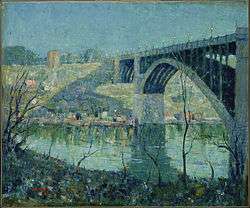Washington Bridge
| Washington Bridge | |
|---|---|
|
Main arch over Harlem River; secondary arch over Metro-North Railroad and Major Deegan Expressway in the Bronx | |
| Coordinates | 40°50′49″N 73°55′41″W / 40.84694°N 73.92806°WCoordinates: 40°50′49″N 73°55′41″W / 40.84694°N 73.92806°W |
| Carries | 6 lanes of roadway; two sidewalks |
| Crosses | Harlem River |
| Locale | Manhattan and the Bronx, New York City |
| Maintained by | New York City Department of Transportation |
| Characteristics | |
| Design | Arch bridge |
| Total length | 2,375 feet (724 m) |
| Longest span | 510 feet (160 m) |
| Clearance below | 134 feet (41 m) |
| History | |
| Opened | December 1, 1888 |
| Statistics | |
| Daily traffic | 57,011 (2012)[1] |
 | |
The Washington Bridge carries six lanes of traffic, as well as sidewalks on both sides, over the Harlem River in New York City between the boroughs of Manhattan and the Bronx, connecting 181st Street and Amsterdam Avenue in the Washington Heights neighborhood of Manhattan to University Avenue in the Morris Heights neighborhood of the Bronx. Ramps at either end of the bridge connect to the Trans-Manhattan Expressway and the Cross-Bronx Expressway. The bridge is operated and maintained by the New York City Department of Transportation. It once carried U.S. Route 1, which now travels over the Alexander Hamilton Bridge.
The total length of the bridge, including approaches, is 2,375 feet (724 m). The parallel main spans of the steel arch bridge stretch 510 feet (160 m) over the Harlem River, providing 134 feet (41 m) of vertical clearance and 354 feet (108 m) of horizontal clearance. The tidal maximum (mean higher high water) is 4.9 ft (1.5 m) and extreme low water is -3.5 compared to mean lower low water.

.jpg)
This two-hinged arch bridge was designed by Charles C. Schneider and Wilhelm Hildenbrand, with modifications to the design made by the Union Bridge Company, William J. McAlpine, Theodore Cooper and DeLemos & Cordes, with Edward H. Kendall as consulting architect.[2][3] The original design was pared down to bring the bridge's cost to $3 million. The bridge features steel-arch construction with two 510-foot-long (150m) main spans and masonry approaches. Construction began in 1886, and the bridge opened to pedestrian traffic on December 1, 1888. The plan had been to open the bridge to vehicular traffic on February 22, 1889 — Washington's Birthday and the centennial anniversary of the first Presidency — but the full opening was delayed until December 1889.
In 1913, a young architect named John Bruns is reported to have jumped from the Washington bridge and lived. He was quoted at his trial: "Why, Your Honor, it was a nerve test. Some friends had been taunting me on my lack of nerve because I had never married, and as we talked over the matter I made a bet that I would dive from the bridge."[4]
After completion of the George Washington Bridge in 1931, traffic off the bridge into the Bronx traveled over the Washington Bridge. Starting in the 1940s, ramps were built to connect the western end of the bridge to the 178th Street and 179th Street Tunnels leading to the George Washington Bridge. This allowed traffic to and from New Jersey to bypass the congested local streets of Upper Manhattan.
The Alexander Hamilton Bridge was planned in the mid-1950s to provide a direct connection between Robert Moses's proposed Trans-Manhattan and Cross-Bronx Expressways and to accommodate the additional traffic resulting from the addition of the six-lane lower level to the George Washington Bridge. The completion of the Alexander Hamilton Bridge in 1963 diverted much of the traffic away from the Washington Bridge.
The Washington Bridge underwent reconstruction from 1989 to 1993.[2][3]
Public transportation
The Washington Bridge carries the Bx3, Bx11, Bx13, Bx35, Bx36 bus routes operated by New York City Bus.[5]
_(14771454094).jpg)
See also
- List of crossings of the Harlem River
- Andrew Haswell Green
- List of bridges documented by the Historic American Engineering Record in New York
- National Register of Historic Places listings in Bronx County, New York
- National Register of Historic Places listings in New York County, New York
References
Notes
- ↑ "2012 New York City Bridge Traffic Volumes" (PDF). Retrieved 2014-09-23.
- 1 2 New York City Landmarks Preservation Commission; Dolkart, Andrew S. (text); Postal, Matthew A. (text) (2009), Postal, Matthew A., ed., Guide to New York City Landmarks (4th ed.), New York: John Wiley & Sons, ISBN 978-0-470-28963-1, p.213
- 1 2 White, Norval; Willensky, Elliot; Leadon, Fran (2010), AIA Guide to New York City (5th ed.), New York: Oxford University Press, ISBN 9780195383867, p.570
- ↑ "Diving 135 feet off Bridge, cries "I'm all right!" Bruns says his plunge from Washington Structure was a Nerve Test". The Evening World. 21 June 1913. p. 5.
- ↑ Bronx Bus Map, mta.info
External links
| Wikimedia Commons has media related to Washington Bridge. |
- NYC Roads: Washington Bridge
- New York City Department of Transportation
- Washington Bridge at Structurae
- Historic American Engineering Record (HAER) No. NY-130, "Washington Bridge, Spanning Harlem River at 181st Street, New York, New York County, NY", 5 photos, 2 data pages, 1 photo caption page
- Nautical Chart #12342 NOAA

